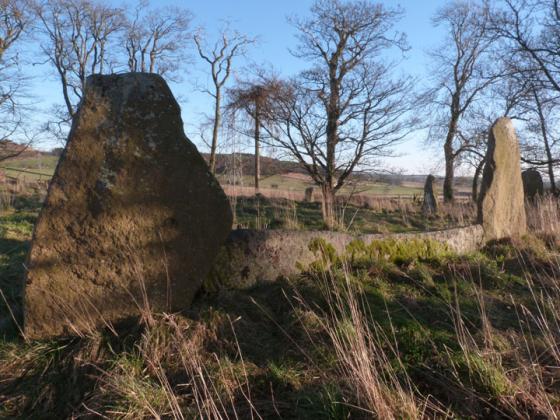
25/12/2023 – The Drum Stone on Christmas Day.

25/12/2023 – The Drum Stone on Christmas Day.
Go thru Kirkton of Skene and take the first tarred road left over the Auchronie Hill going past the standing stone of the same name. Go to the end of this road and turn left. The site is a further 1/2 mile and space has been provided for at least two cars to park.
Open the gate and you will face a modern wall surrounding the white stone which has been concreted into the ground. It is some 41/2 feet wide and 21/2 feet high. Although this stone has been here a long time it has “Drum Stone/1411/Harlaw” inscribed.
Visited 9/07/09.
There was a deadly feud between the Keiths and the Irvines. The Keiths were the ‘Marischals of Scotland’ which meant they kept tabs on the Scottish Crown Jewels, and looked after the king when he went to parliament. The Irvines also had a good pedigree, having been co-adventurer with Robert the Bruce. Eventually Alexander Irvine was asked to put a stop to all the feuding by marrying the daughter of the Marischal, which he did.
But, there was fighting with other people to be done, namely with Donald, Lord of the Isles. On the way to a battle at Harlaw,
..accompanied by his brother Robert, he [Irvine of Drum] halted upon the hill of Auchrony, in the parish of Skene, from the summit of which the house of Drum was visible on the one hand, and the field of battle on the other, and there seated on a stone, which still bears the appellation of Drum’s Stone, he advised Robert (if he himself should be slain), to marry his sister-in-law on his return, with whom, as he assured him, he had never consummated his marriage.
Irvine was killed, and there was, it’s said, a cairn at the site of his death, or perhaps of his burial. But according to the RCAHMS, there’s no trace now (at NJ 7513 2410). Apparently, (again taking my information from the New Statistical Account) “Robert having escaped the slaughter, married the lady according to [the] advice, and, upon succeeding to the estates, changed his Christian name to Alexander.” Now isn’t that a touch weird. Maybe that was normal in those days?! And can we really believe that the original Alexander’s marriage was such a feud-breaking device, if it was never consummated? But I don’t pretend to understand 15th century domestic and political arrangements.
1411 was the year when battle of Harlaw took place slightly to the north of Inverurie. This stone had stood for centuries until this mob disturbed it’s rest.
“Traditionally it was at this stone that the Laird Of Drum halted his men on their way to the battle of Harlaw. At this point he rested and arranged his affairs.”
Aberdeen Journal Notes and Queries 1908.































































































































































































































































